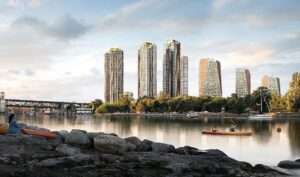

As in many parts of the United States, several large cities in Canada have a severe housing shortage caused by exclusionary zoning, which is regulations that prohibit or severely limit the construction of low-cost multifamily housing. In some places, however, Canada’s indigenous nations (known as “First Nations”) have managed to circumvent these rules. A recent article in the Canadian publication Maclean has an interesting description of one such project in Vancouver (one of the cities most severely affected by zoning restrictions):
Vancouver has long been nicknamed the “Glass City” for its glittering skyline of skyscrapers. Over the next few years, that skyline will get a major new addition: Sen̓áḵw, an 11-tower complex that will tetrify 6,000 apartments on just over 10 acres of land in the heart of the city. Once completed, this will be the most densely populated neighborhood in Canada, providing thousands of homes to Vancouverites who have long been squeezed between the country’s most expensive real estate and some of the lowest vacancy rates.
Sen̓áḵw is big, ambitious and undeniably urban, and undeniably indigenous. It was built on reserve land owned by the Squamish First Nation, and is led by the Squamish Nation, in partnership with private real estate developer Westbank. Because the project is on First Nations land, not city land, it is under the authority of Squamish, free from Vancouver’s zoning rules. And the Nation has chosen to build buildings larger, denser and taller than any development on city property would allow.
The project has been criticized by a coalition of NIMBY and left-wing interests angry that the Squamish Nation has moved away from “Indigenous ways of being”:
Predictably, not everyone was happy about it. Critics have included local city planners, politicians and, most importantly, residents of Kitsilano Point, a rare beachfront neighborhood bordering the reservation. And there was an added edge to their criticism that went beyond the standard NIMBYism about buildings being too tall and preserving neighborhood character. There has also been a lingering sense of disbelief that indigenous people could be responsible for this futuristic version of urban life. In 2022, Gordon Price, a prominent Vancouver urban planner and former city councilor, told Gitxsan reporter Angela Sterritt: “When you build 30, 40-story concrete skyscrapers, there’s a big gap between that and an indigenous way. to build.”
…. In 2022, City Councilor Colleen Hardwick said [a similar development], “How to reconcile the indigenous way of life with 18-story skyscrapers?” (Hardwick, of course, is not indigenous.)
…What irritates critics, even those who might consider themselves progressive, is that they expect reconciliation to instead seem like a kind of reversal, rewinding the tape of history to a museum-diorama past. Coalitions of neighbors near Iy̓álmexw and Sen̓áḵw have presented their own counterproposals for the development of the sites, envisioning smaller, lower buildings and other changes. At the January hearing for Iy̓álmexw, a resident called on First Nations to build entirely with selectively harvested timber in BC, in accordance with what she argued were their cultural values… This attitude can cast Indigenous people as glorified park ranger.
The Squamish Nation is right to ignore both NIMBYs and left-wing opponents. NIMBYism should not be allowed to undermine property rights and block much-needed housing development. In places where demand is high and housing construction is severely limited, many current homeowners also have much to gain from legalizing new developments.
As for the idea that First Nations should stick to “indigenous ways of being,” the right answer is that they should be able to build whatever type of housing they want. White progressive critics of the Squamish project surely would not accept such constraints for themselves. Should the descendants of white Europeans also be limited to building the kind of homes their ancestors built centuries ago, using the same kinds of materials? If it was good for your medieval peasant ancestors, it’s good for you too!
Economist Alex Tabarrok (my colleague at George Mason University) notes that the Vancouver project is an example of the “charter city” concept in action, and highlights similar developments in the United States:
The Catawba Indian Nation, for example, established the Catawba Digital Economic Zone (CDEZ), for which I serve as an advisor. The CDEZ is based on US law but is tailored for digital entrepreneurs, freelancers, FinTech, digital assets, Web3 and other exponential digital technologies. The progressive left is probably not happy about it either. Personally, I am happy to support initiatives that empower indigenous communities through capitalist ventures. More generally, however, I support the introduction of new governance models to encourage competition in governance: ushering in a new era of discovery and competition Tiebout!
My only complaint is that indigenous groups shouldn’t be the only ones exempt from exclusionary zoning regulations. Such restrictions should be abolished for all property owners, regardless of race or ancestry.
In the United States, I believe this should be accomplished through a combination of legislative reforms and stronger judicial enforcement of the Fifth Amendment’s Takings Clause. Canada’s Charter of Rights and Freedoms does not include protection of property rights. So the optimal reform strategy is likely to be different.